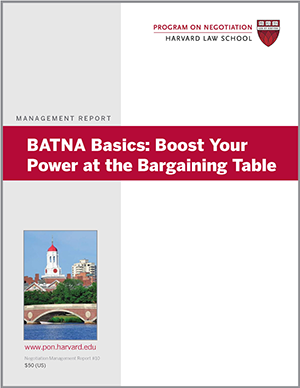
Some negotiators seem to believe that hard-bargaining tactics are the key to success. They resort to threats, extreme demands, and even unethical behavior to try to get the upper hand in a negotiation.
In fact, negotiators who fall back on hard-bargaining strategies in negotiation are typically betraying a lack of understanding about the gains that can be achieved in most business negotiations. When negotiators resort to hard-bargaining tactics, they convey that they view negotiation as a win-lose enterprise. A small percentage of business negotiations that concern only one issue, such as price, can indeed be viewed as win-lose negotiations, or distributive negotiations.
Much more commonly, however, business negotiations involve multiple issues. As a result, these so-called integrative negotiations give parties the potential to create win-win outcomes, or mutually beneficial agreements. Business negotiators can negotiate by brainstorming creative solutions, identifying differences in preferences that can be ripe for tradeoffs, and building trust.
Unfortunately, when parties resort to hard-bargaining tactics in negotiations with integrative potential, they risk missing out on these benefits. Because negotiators tend to respond in the way they are treated, one party’s negotiation hardball tactics can create a vicious cycle of threats, demands, and other hardball strategies. This pattern can create a hard-bargaining negotiation that easily deteriorates into impasse, distrust, or a deal that’s subpar for everyone involved.
10 Common Hard-Bargaining Tactics & Negotiation Skills
To prevent your negotiation from disintegrating into hard-bargaining tactics, you first need to make a commitment not to engage in these tactics yourself. Remember that there are typically better ways of meeting your goals, such as building trust, asking lots of questions, and exploring differences.
Next, you need to prepare for your counterpart’s hard-bargaining tactics. To do so, you first will have to be able to identify them. In their book Beyond Winning: Negotiating to Create Value in Deals and Disputes, Robert Mnookin, Scott Peppet, and Andrew Tulumello offer advice to avoid being caught off-guard by hard bargainers. The better prepared we are for hard-bargaining strategies in negotiation, the better able we will be to defuse them.
Here is a list of the 10 hardball tactics in negotiation to watch out for from the authors of Beyond Winning:
- Extreme demands followed up by small, slow concessions. Perhaps the most common of all hard-bargaining tactics, this one protects dealmakers from making concessions too quickly. However, it can keep parties from making a deal and unnecessarily drag out business negotiations. To head off this tactic, have a clear sense of your own goals, best alternative to a negotiated agreement (BATNA), and bottom line – and don’t be rattled by an aggressive opponent.
- Commitment tactics. Your opponent may say that his hands are tied or that he has only limited discretion to negotiate with you. Do what you can to find out if these commitment tactics are genuine. You may find that you need to negotiate with someone who has greater authority to do business with you.
- Take-it-or-leave-it negotiation strategy. Offers should rarely be nonnegotiable. To defuse this hard-bargaining tactic, try ignoring it and focus on the content of the offer instead, then make a counter-offer that meets both parties’ needs.
- Inviting unreciprocated offers. When you make an offer, you may find that your counterpart asks you to make a concession before making a counteroffer herself. Don’t bid against yourself by reducing your demands; instead, indicate that you are waiting for a counteroffer.
- Trying to make you flinch. Sometimes you may find that your opponent keeps making greater and greater demands, waiting for you to reach your breaking point and concede. Name the hard-bargaining tactic and clarify that you will only engage in a reciprocal exchange of offers.
- Personal insults and feather ruffling. Personal attacks can feed on your insecurities and make you vulnerable. Take a break if you feel yourself getting flustered, and let the other party know that you won’t tolerate insults and other cheap ploys.
- Bluffing, puffing, and lying. Exaggerating and misrepresenting facts can throw you off guard. Be skeptical about claims that seem too good to be true and investigate them closely.
- Threats and warnings. Want to know how to deal with threats? The first step is recognizing threats and oblique warnings as the hard-bargaining tactics they are. Ignoring a threat and naming a threat can be two effective strategies for defusing them.
- Belittling your alternatives. The other party might try to make you cave in by belittling your BATNA. Don’t let her shake your resolve.
- Good cop, bad cop. When facing off with a two-negotiator team, you may find that one person is reasonable and the other is tough. Realize that they are working together and don’t be taken in by such hard-bargaining tactics.
Are there any other hard-bargaining strategies in negotiation that you’ve encountered that you would add to this list? We would love to hear from you!






Bargaining tactics can be a game-changer in negotiations, staying vigilant against them is key for success.
This article provides an invaluable guide for recognizing and navigating through the maze of hardball tactics often encountered in negotiations. The detailed breakdown of each tactic not only prepares negotiators to identify them but also offers strategies to effectively counter these approaches. It’s a reminder that understanding and preparation are key to maintaining a level-headed approach in the face of potentially aggressive and unethical negotiation strategies. This insight is particularly valuable in fostering an environment where mutually beneficial outcomes can be achieved despite the challenges. Excellent and practical advice for any negotiator.
In a negotiation, being aware of hard-bargaining tactics is crucial. Watch out for tactics such as ‘highballing’ (starting with an unrealistically high offer), ‘lowballing’ (initially offering too low), ‘good cop, bad cop’ (using a friendly and a tough negotiator), and ‘nibbling’ (making small last-minute demands). ‘Silent treatment,’ ‘time pressure,’ ‘appeal to higher authority,’ ‘flinching,’ ‘straw man,’ and ‘exploding offer’ are other tactics to recognize. Being vigilant can help you respond effectively, maintain fairness, and achieve a mutually beneficial agreement during negotiations.
If the “other side” is your “opponent” then you are not negotiating, you are engaged in warfare. There is no trust, no reasonableness, and no common set of interests. This is not a negotiation; it’s a battle of power, a game of wits, a test of wills, and a mastery of manipulation. Recognize the “opponent” is trying to conquer you, and negotiations are simply a deception to give the false illusion that a reasonable outcome is possible.
Whoever is destined to lose will lose big-time unless they increase the power-balance on their side.
Also, recognize that value will actually be destroyed in this process – it will more than likely devolve into a lose-lose.
These rules of engagement were used by Ignacio Lopez at General Motors in the 1990s, and it resulted in poor quality cars to the extent that warranty costs exceeded profits year after year.
It makes a lousy procurement strategy and is likely to result in higher total costs of ownership, which seldom get considered in the heat of the battle.
If you get caught in this mess, it’s better to walk away and do business with reputable, trustworthy business entities.
This article assisted me during my procurement assignment, cheers to the author
This article assisted me during my procurement assignment, cheers to the author
This article assisted me during my procurement assignment, cheers to the author
As negotiation prof, it’s tricky to teach these concepts without addressing how various national & international “leaders” uses these tactics. I can teach students not to use or bend to them, but they see it being used by people to maintain and acquire power. This mismatch of what I say and what they see must be addressed.
This article assisted me during my procurement assignment, cheers to the author
Never knew that seating plan can have this big effect. Excellent example and beautiful explanation
An excellent summation of the Harvard Method. I imagine that your counter-parts enjoy reaching mutually beneficial agreements with you.
In other words, the Trump Negotiation Method. Good article. Thank you.
my rules of bargaining are simple.
1. understand what you want to achieve.
2. understand what the other side wants to achieve
3. understand the why for both
4. understand each other’s walk away point
5. negotiate, negotiate, negotiate, negotiate
6. never let the other side walk away empty handed.
7. never go into a negotiation you are not prepared to walk away from.
There are two general types of bargaining, distributive bargaining and integrative bargaining.
Recently found this post. It’s a great list. I tend to think, based upon experience that negotiation is as much about education as it is about preparation. Preparation is key – knowing your worth, knowing your industry and knowing your negotiating partner’s industry and needs. But I find the best way to reach the maximum potential of any negotiation is when you are controlling the narrative and educating your negotiating partner in a persuasive manner. Here is a blog I recently wrote discussing that sort of preparation and education. http://www.thenewyorklawblog.com/2016/07/negotiation-basics-newyork-small-business.html
This is a helpful list.
I understand the point about bidding against oneself, but there are times when it is to your advantage. Let’s say your “opponent” makes a very high anchor; you counter with a very low anchor. Let’s say your “opponent” says “you have to do better.” It is to your advantage that your opponent has accepted your anchor as the focal point rather than his high anchor. It is easier to inch up to find the other person’s reservation price, than having to work down from a high first offer. I would just as soon my opponent not hold on to his anchor but rather accepts mine. If that means bidding against myself, so be it.
Very astute comment. Thank you.
I loved the article! I believe in negociation!